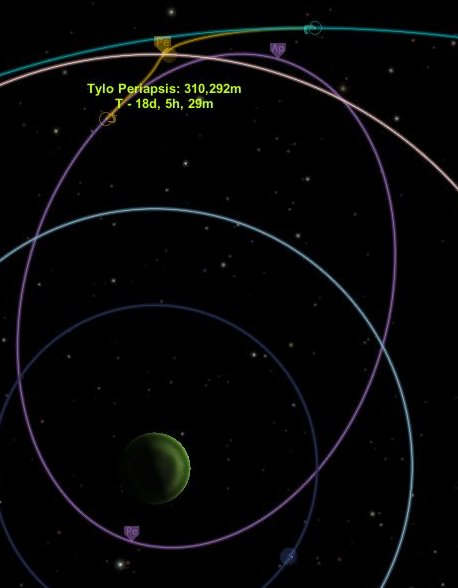Difference between revisions of "Tutorial: Gravity Assist/zh-cn"
From Kerbal Space Program Wiki
m |
|||
| (5 intermediate revisions by one other user not shown) | |||
| Line 1: | Line 1: | ||
| − | [[File:Gravitational slingshot.svg|right|thumb|200px| | + | [[File:Gravitational slingshot.svg|right|thumb|200px|引力弹弓效应的极简模型:飞船速度可以得到2倍行星速度的叠加]] |
| − | + | 引力助推是一种非常节约燃料的加速(或减速)机动方式。这种机动就是,当位于天体的引力范围球体之内时,它会对飞船产生一定的牵引力,从而相应为飞船产生加速(或减速)的效果。当你飞离某颗行星,如果它有卫星,那么我们就可以利用该卫星进行引力助推机动,从而节约大量的燃料。 | |
*'''长度:'''30分钟 | *'''长度:'''30分钟 | ||
| Line 7: | Line 7: | ||
*'''对应版本:'''0.18.4 | *'''对应版本:'''0.18.4 | ||
| − | == | + | == 如何进行 == |
| − | + | 在这个例子里,我们要离开Kerbin,利用Mun完成引力助推,并进入前往Duna的轨道。通常,你需要把轨道远点高度提升到八千五百万公里才能脱离Kerbin。用这个办法,我们只需要进入Mun轨道(一千两百万公里)就可以。这样可以为你节约相当于几百m/s delta-v的燃料。 | |
| − | # | + | # 飞船进入环Kerbin低圆周轨道; |
| − | # | + | # 缩小图像直到可以看到Kerbin的公转轨道; |
| − | # | + | # 按照"Going to the Mun"教程中学到的方法,安排前往Mun的飞掠轨道,需要注意的一点是,应该注意到达Mun时,它正向你需要的方向前进。在本例中,我们需要的是飞离太阳的方向,因此在设计轨道时注意Mun的运行方向 —— 即Mün轨道与Kerbin公转轨道交汇的时刻; |
| − | # | + | # 加速时间,直到抵达Mun的引力范围; |
| − | # | + | # 现在规划一次轨道校正机动。因为引力助推离目标天体距离越近效果越明显,所以只要不发生碰撞,离Mun越近越好。你的Mun轨道近点应位于Mün运行方向的后方。如果飞船从前方经过Mun,你会减速而不是加速。同时应注意轨道的倾角 —— 太高就会有问题了; |
| − | # | + | # 加速时间,直到离开Mun的引力范围; |
| − | # | + | # 观察轨道地图,你会发现飞船现在的轨道比飞掠Mun前变得更长(轨道远点很可能位于Minmus轨道的后方),但它并不是Kerbin的逃逸轨道。你还没有从Mun获得足够的全部速度; |
| − | # | + | # 所以,再进行一次轨道校正机动,再度飞掠Mun,并尽可能靠近它飞行; |
| − | + | 祝贺你,你现在会进入一条大致飞向Duna的轨道,而又为返程省下了足够的燃料。如果希望返回Kerbin,你可以利用Ike进行类似的机动。 | |
| − | == | + | == 反向引力助推 == |
| − | [[File:Gravity Assist.svg|right|thumb|200px| | + | [[File:Gravity Assist.svg|right|thumb|200px|从目标卫星的前方飞掠进行减速,从后方飞掠进行加速]] |
| − | + | 假如你以合适的轨道进入Duna-Ike行星系统后,你可以利用反向引力助推进行减速飞行。具体办法就是进行一次Ike的飞掠。记住我们的目标是减速而非加速,因此需要把轨道近点放在Ike轨道的前方而不是后方。 | |
| − | == | + | == 动力推进型引力助推 == |
| − | + | 为了进一步提高引力助推的效果,你可以在引力助推过程中同时进行发动机点火推进。正如你所知道的,在轨道近点附近推进可以非常有效的改变轨道远点。这对于引力助推一样适用。在飞掠加速中发动机同时推进,燃料消耗的效率可以最大化,很有效的提升轨道远点。然而,这是一项很有难度的机动操作控制,因为即便利用机动模式协助,你也很难控制好最终的轨道。 | |
| − | [[File:Jool gravity assist deceleration.jpg|500px|left|thumb| | + | [[File:Jool gravity assist deceleration.jpg|500px|left|thumb|利用Tylo进行反向引力助推,进入环Jool轨道。相比[[Aerobraking/zh-cn|气动刹车]],这一机动消耗的燃料量较少,而且也更加安全。]] |
Latest revision as of 03:44, 2 July 2021
引力助推是一种非常节约燃料的加速(或减速)机动方式。这种机动就是,当位于天体的引力范围球体之内时,它会对飞船产生一定的牵引力,从而相应为飞船产生加速(或减速)的效果。当你飞离某颗行星,如果它有卫星,那么我们就可以利用该卫星进行引力助推机动,从而节约大量的燃料。
- 长度:30分钟
- 难度:适中
- 对应版本:0.18.4
如何进行
在这个例子里,我们要离开Kerbin,利用Mun完成引力助推,并进入前往Duna的轨道。通常,你需要把轨道远点高度提升到八千五百万公里才能脱离Kerbin。用这个办法,我们只需要进入Mun轨道(一千两百万公里)就可以。这样可以为你节约相当于几百m/s delta-v的燃料。
- 飞船进入环Kerbin低圆周轨道;
- 缩小图像直到可以看到Kerbin的公转轨道;
- 按照"Going to the Mun"教程中学到的方法,安排前往Mun的飞掠轨道,需要注意的一点是,应该注意到达Mun时,它正向你需要的方向前进。在本例中,我们需要的是飞离太阳的方向,因此在设计轨道时注意Mun的运行方向 —— 即Mün轨道与Kerbin公转轨道交汇的时刻;
- 加速时间,直到抵达Mun的引力范围;
- 现在规划一次轨道校正机动。因为引力助推离目标天体距离越近效果越明显,所以只要不发生碰撞,离Mun越近越好。你的Mun轨道近点应位于Mün运行方向的后方。如果飞船从前方经过Mun,你会减速而不是加速。同时应注意轨道的倾角 —— 太高就会有问题了;
- 加速时间,直到离开Mun的引力范围;
- 观察轨道地图,你会发现飞船现在的轨道比飞掠Mun前变得更长(轨道远点很可能位于Minmus轨道的后方),但它并不是Kerbin的逃逸轨道。你还没有从Mun获得足够的全部速度;
- 所以,再进行一次轨道校正机动,再度飞掠Mun,并尽可能靠近它飞行;
祝贺你,你现在会进入一条大致飞向Duna的轨道,而又为返程省下了足够的燃料。如果希望返回Kerbin,你可以利用Ike进行类似的机动。
反向引力助推
假如你以合适的轨道进入Duna-Ike行星系统后,你可以利用反向引力助推进行减速飞行。具体办法就是进行一次Ike的飞掠。记住我们的目标是减速而非加速,因此需要把轨道近点放在Ike轨道的前方而不是后方。
动力推进型引力助推
为了进一步提高引力助推的效果,你可以在引力助推过程中同时进行发动机点火推进。正如你所知道的,在轨道近点附近推进可以非常有效的改变轨道远点。这对于引力助推一样适用。在飞掠加速中发动机同时推进,燃料消耗的效率可以最大化,很有效的提升轨道远点。然而,这是一项很有难度的机动操作控制,因为即便利用机动模式协助,你也很难控制好最终的轨道。

利用Tylo进行反向引力助推,进入环Jool轨道。相比气动刹车,这一机动消耗的燃料量较少,而且也更加安全。

